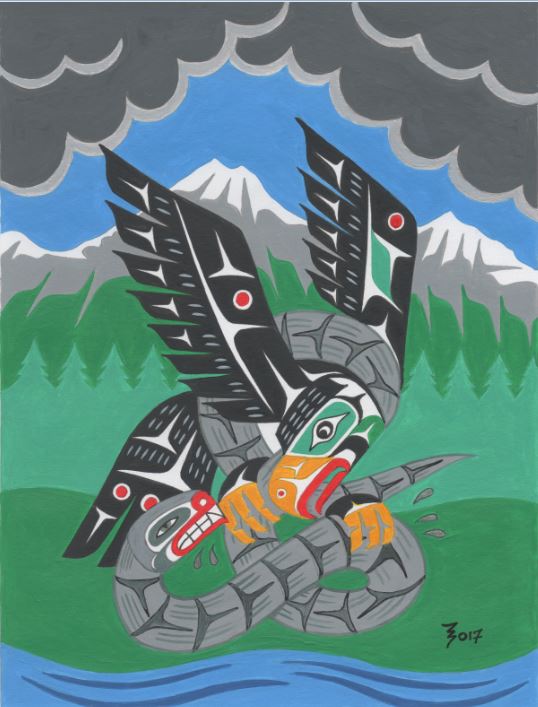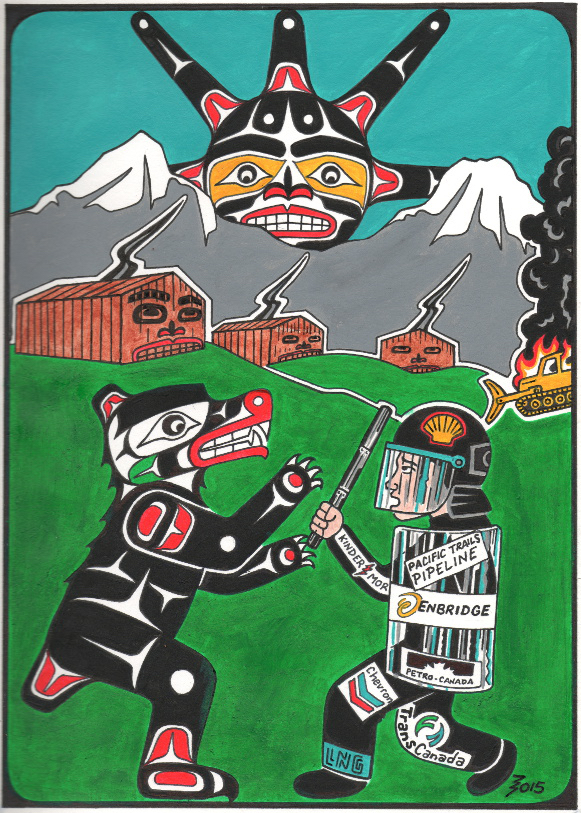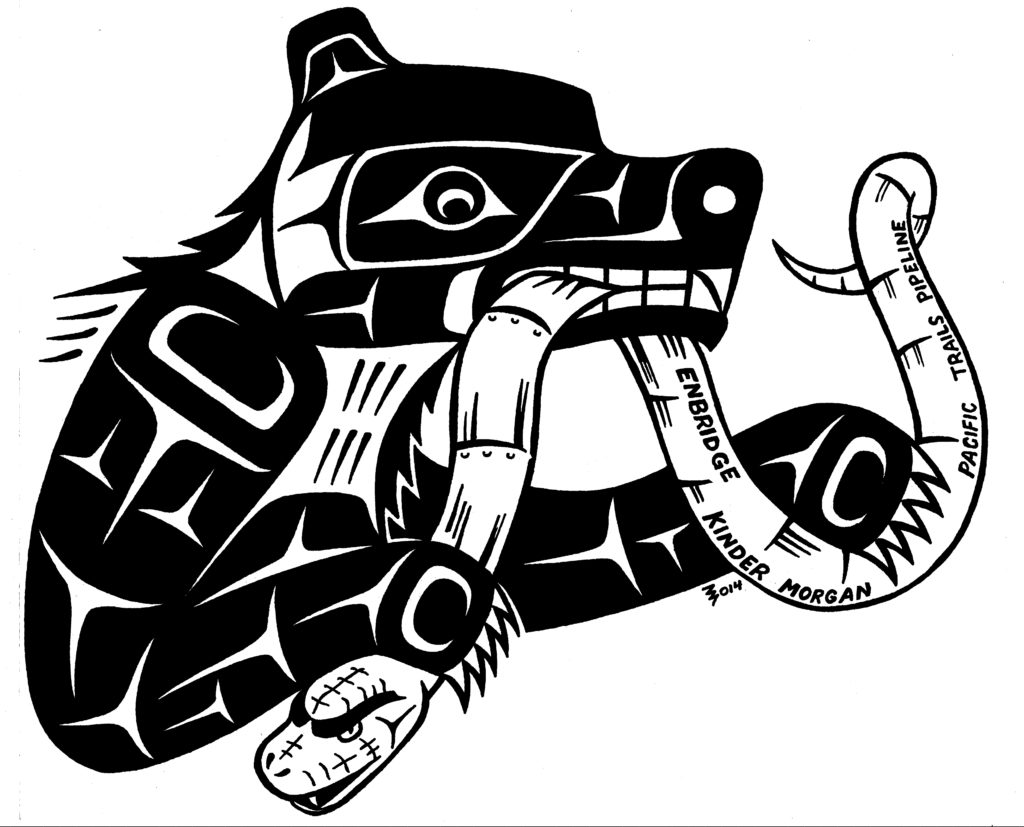Rail and highway blockades have proliferated across Canada since Februrary 6, when the RCMP, western Canada’s colonial police force, began raiding a series of camps that stand in the way of proposed gas pipelines in unceded Wet’suwet’en territory.
These and other solidarity actions in Canada, the US and worldwide have brought the demands of the Wet’suwet’en hereditary chiefs to the forefront of Canada’s political agenda. Yesterday morning, the Ontario Provincial Police raided a solidarity encampment near the rail lines that pass through Tyendinaga Mohawk territory, arresting 10.
In order to deepen our reflection on these events, and put them into recent historical context, I interviewed Gord Hill. He’s a member of the Kwakwaka’wakw nation, an artist, the author of the 500 Years of Resistance comic book and the Antifa comic book, as well as the editor of Warrior Publications.
I reached Gord by phone at his home on Monday, February 24th, as reports began to come in that Gitxsan land defenders were being arrested in New Hazelton. What follows is a lightly edited transcript of our interview, and some of Gord’s powerful images related to anti-pipeline struggles.
Dawn Marie Paley: You’ve been following all kinds of struggles in Canada in the US for more than 20 years now… Do you think what’s happening now, since February, with #ShutDownCanada is new, or have you seen these kind of actions before?
Gord Hill: In some ways its new because it hasn’t happened for quite a while, and there’s a new generation of kids and young people getting involved, it’s kind of like the product of several years of these kinds of mobilizations that have been happening in Canada. Idle No More is one that comes to mind, where you had thousands of Native people rallying in the streets and whatnot. There’s a timeline to it that creates the situation today.
But I think if you look back, during Oka, in 1990, there was pretty widespread solidarity actions across the country that included a lot of highway blockades and train blockades. It’s not without precedent. But there’s some differences I find today with this Wet’suwet’en solidarity movement. Its pretty widespread, its a widespread national action but it’s spontaneous, and it just seems like it is kind of unprecedented, certainly for the scale and the time that this has happened within. Oka was a 77 day standoff. So that’s like almost two and a half months. But this has been fairly quickly developing.

Another thing that informs this is the Unist’ot’en because they have done years of organizing and a lot of networking, they’ve travelled back and forth across the country, they’ve created this large network and I think that’s a big part of why this response is really widespread.
And then the train blockade thing as a particular tactic, I think is also unprecedented, even though its a common tactic used by Native people, but to see it on such a large scale, its like this poplar direct action tactic now, and once it started with Tyendinaga on February 6th I think it just kept building and they were like the anchor that established this, cause they’ve been doing it for years there too, but its like this anchor that established and then it just became easier and easier for people to step up and do these train blockades. There must have been over two dozen train blockades over the last few weeks.
DMP: Were you surprised by the arrests on Tyendinaga this morning?
GH: No, this being a common tactic used by the Tyendinaga Mohawk, because the railway runs right there, right through their territory, so the common ending is the Ontario Provincial Police (OPP) gather a very large force and they move on the Tyendinaga blockade encampment and they just arrest a few people and that’s the end of it. They’re a really strong community and they do this somewhat frequently, but this is kind of what usually happens: the OPP just mass and then go in and remove them.
There’s certainly been an increase in actions today resulting from the Tyendinaga raid, Kanehsatake blocked Highway 334 that runs through their territory, and they set up checkpoints around their reserve, and then Kahnawake still has that train blockade, and then they were disrupting traffic on the Mercier bridge. So those are the bigger things that the state is looking at right now, the response from the Mohawk and the Haudenosaunee because of the Tyendinaga link. The Six Nations are still blocking a rail line and part of Highway 6. It did provoke more response as it has in the past when Tyendinagans faced this kind of arrests.
Also I seen the Gitxsan had re-established their blockade in New Hazelton and it looks like they’re being arrested as we’re speaking. The other thing that was kind of particular about the Tyendinaga one was that it lasted for so long. I don’t know if previously their blockades lasted this long, and that’s because of the overall context of what’s going on with all these solidarity actions and stuff like that.
DMP: What about up there where you are? Are people taking action and talking about it?
GH: There was a small rally last week organized by some people here, there was probably 30-40 people who rallied to show their solidarity and then there was one up near the Nimpkish bridge, which is the main bridge that crosses the Nimpkish River, which is the only way you can get up to Port Hardy and Port MacNeil. There was a rally on the side of the road there.
But certainly everyone is talking about it, I mean this is definitely having a big impact on people throughout Canada, particularly for Indigenous people, this is very empowering to see, and I think by how many actions are occurring people are really motivated and inspired to get out and do stuff.

DMP: Can you trace back for us through time some of the social struggles that have brought us to this point? What’s informing this cycle of struggle that feels like it is opening in Canada today?
GH: This movement wouldn’t exist without everything that preceded it. So the [campaign against the] 2010 Olympics, the anti-tarsands campaign, the anti-Northern Gateway Pipeline campaign, Idle No More, the Elsipogtog anti-fracking struggle in New Brunswick, Six Nations in 2006, I think all these things inform the present and what this movement is. All those different movements contributed to the movement that we’re seeing on the streets today. All the work that was done by Indigenous people and non-Indigenous people building solidarity and all this work that’s been done over the years.
I would even go back to Oka, because you still see the Mohawk unity flag, the warrior flag, flying all across the country at these rallies and blockades. Oka really set the tone for the 1990s and it continues to today. You even have federal ministers referring to this spectre of Oka and Ipperwash, this spectre of intense, high level social conflict, armed resistance, Indigenous insurgency, this spectre it still resonates from Oka and I think that’s another important part that’s contributing to this movement, even though its totally unarmed and its really more like a civil disobedience campaign.
[This movement] just has a certain militancy about it that you haven’t seen, certainly the Idle no more wasn’t about this at all. The few blockades that were proposed under the Idle No More banner were really shut down by the leadership and other elements within the Idle No More movement that just saw itself as completely pacifistic and non-violent. Anything to do with militancy they completely distanced themselves from. So that’s another change this time, is the willingness to carry out direct action, and going back to violate injunctions, like the Gitxsan went back, they had an injunction served to them; at the legislature today, there was like a few hundred people gathered there, there was an injunction served last week when people were doing this, to bar people from blocking doorways and that. So that’s another part that I’m seeing in all of this, is like this willingness to take direct action and face the consequences.
And also it seemed like what happened in Tyendinaga, I mean I don’t know how widespread this image is but, I mean when the OPP went to arrest the Tyendinaga, there was just a handful of kind of warrior types on the roadway, and there was like 30 police lined up ready to arrest them, and still they just stood their ground and there was like a skirmish. It is kind of inspiring, even though it is overall just a kind of low level, civil disobedience campaign that’s occurring.
DMP: Can you talk about the strategy of trying to marginalize the Wet’suwet’en, people like Conservative leader Andrew Scheer or Alberta Premier Jason Kenney stating that it is just a local issue and that people in Edmonton or Ottawa for example have no reason to protest.
GH: I’ve seen a few comments by government officials and mayors belittling the protests, being like, ‘we have nothing to do with Wet’suwet’en or Coastal Cas Link.’ They’re trying to undermine the solidarity movement, saying people shouldn’t act in solidarity, that this is just a local struggle way out there. It’s a weak tactic to try and undermine it.
In terms of Scheer and the Conservative Party and the right wing, I mean certainly we’ve seen fairly significant backlash from what you could describe as far right and right wing racists towards a lot of these blockades.
The first significant one was just outside Courtney on north Vancouver Island. They had a little blockade that was blocking Highway 19 there, and a group of local rednecks came up and started dismantling the blockade. There was police there, so the ringleader of these vigilantes was arrested, he was released later without charge but they arrested him. Later that night about 30 guys showed up and were lined up on either side of the highway threatening the encampment so they took down their camp, and dismantled the blockade, because the police told them they wouldn’t be able to guarantee their safety up on the highway there. So that was the first one.
That definitely inspired other actions. At a number of the other blockades you saw groups of counterprotesters showing up, like in Edmonton where a group of counterprotesters showed up there with a pickup truck and they just started showing all the barricade material into the pickup truck, and that blockade also ended itself, because they felt concerned about their safety.
In Saskatoon there was a blockade of a CP rail line and there has been almost an equal number of counterprotesters that showed up waving Canadian flags and that, and there’s been calls for groups to organize and go down to Tyendinaga before that was raided by the police this morning. You see this kind of increase in the calls for vigilanteism and the actual taking action by these groups, and a part of that is that we’ve seen more organizing and networking by the far right over the last few years, really empowered also by the Trump election and that. In Edmonton, you’ve seen a lot of rallies by far right groups and I think this networking helps them organize like a small mob to go down and confront a native blockade. I think that’s part of what’s going on.
DMP: So we could read these comments by Kenney and Scheer as racist dogwhistles, basically?
GH: Yeah, totally.

DMP: So what’s the best case scenario here?
GH: The Unist’ot’en are in a hard situation just based on the terrain, cause there’s just that one access road, the forest service road, that the RCMP basically control. But the RCMP have had a permanent detachment on this forest road for over a year now, they call it the Community Industry Safety office. So apparently yesterday the police closed that down. But they still patrol the roadway and they escort the Coastal Gas Link heavy machinery up and down the road, so they’re always there. So that demand hasn’t been met.
And now the linchpin of the rail blockade, Tyendinaga, has been taken down, so we’re just going to have to see how strong the response is going to remain in Kanehsatake, Kahnawake and Six Nations, and how many more of these blockades occur and for how long. A lot of them pop up for a day and they’re gone, some of them have injunctions served on them so the police will be able to act a lot quicker, like what’s happening in New Hazelton right now. They’re being removed from the tracks.
Coastal Gas Link, the last I saw was that the BC Environmental Office had rejected part of their technical plan which would impact the Unist’ot’en healing center, so they have to go back and revise, they have 30 days to respond, but there’s still heavy machinery going up and down that forest road. So its just like business as usual is going on in Unist’ot’en territory right now, the police are still there, the work looks like its still proceeding. So its hard to say.
All 20 Wet’suwet’en bands signed on agreements with Coastal Gas Link, so there’s obviously also segments of the community that support this pipeline. Then you have the wider solidarity actions which from what I can gather narrowed their focus down to the RCMP have to remove themselves from the Unist’ot’en territory. So I don’t think those demands will be met, despite the maneuvering that the RCMP did, like closing down their office and that. I think that a lot of the advantage that the blockades have is running its course now, but we’ll have to see. It will probably hinge a lot on the response from the Mohawk communities in response to the Tyendinaga raid.
DMP: I noticed you published something recently on Warrior Publications about how reconciliation is dead…
GH: It seems like a good slogan. It was just rhetoric that the government would use to pacify Indigenous people. It’s good if the idea is that it’s dead. Nothing really fundamentally changes despite talk about reconciliation or self government of whatever. I think the idea, the slogan ‘reconciliation is dead’ is good because it points to the idea that reconciliation isn’t what the state wants, it just wants the pacification of its people.
